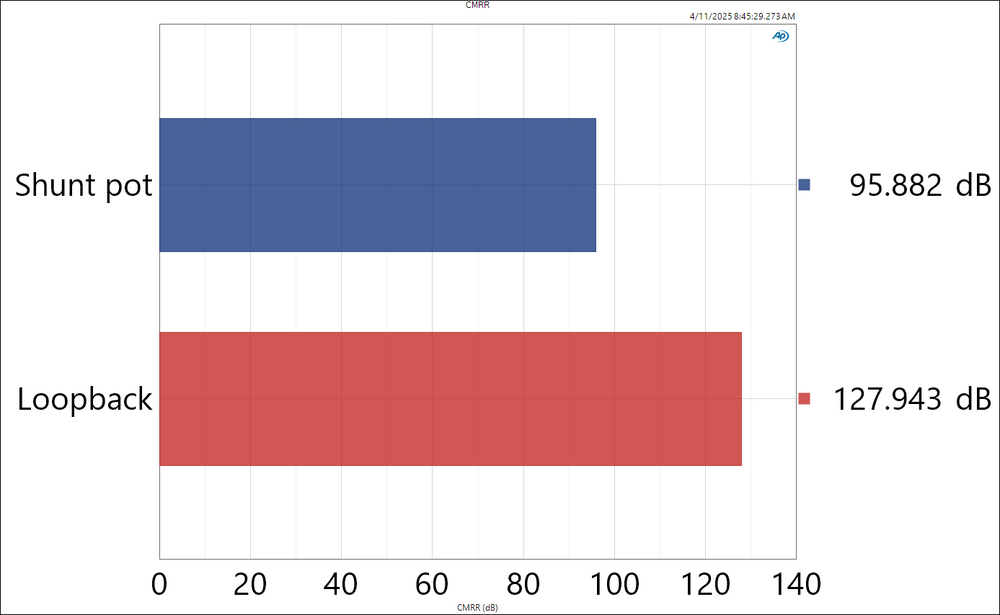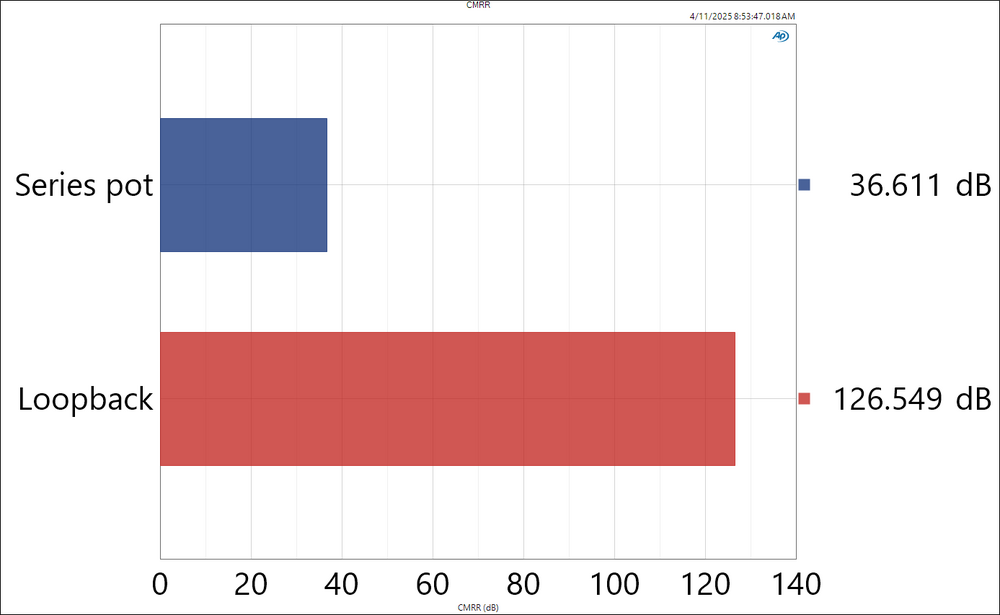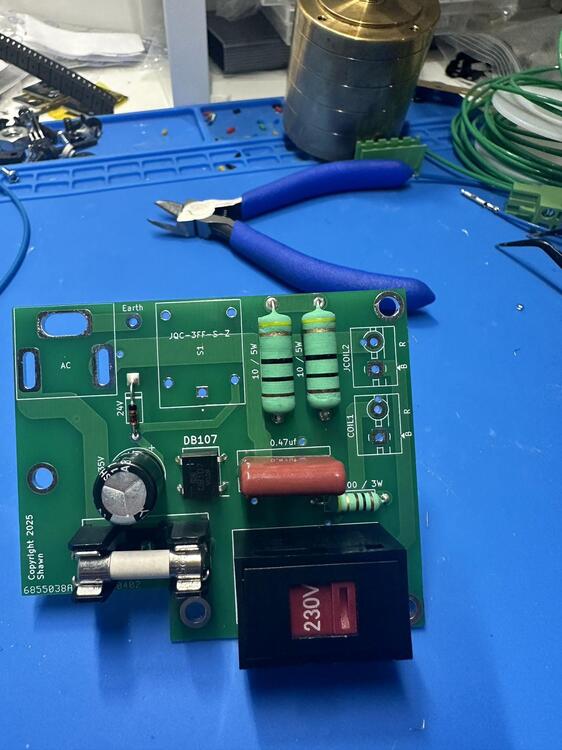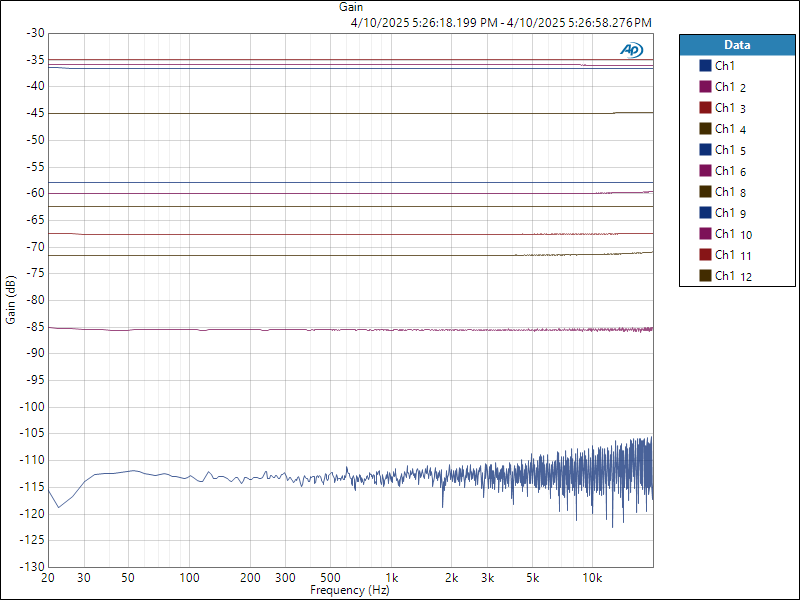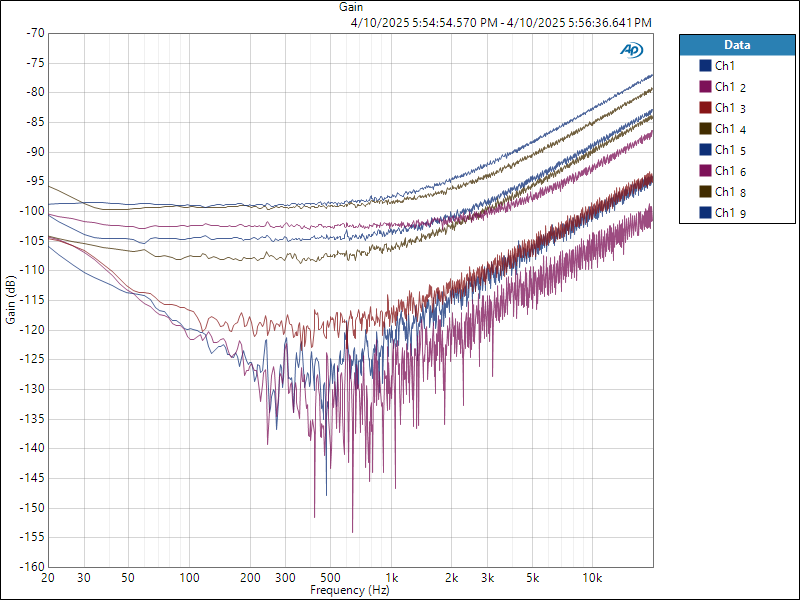All Activity
- Past hour
-
More Than A Feeling by Boston (1976) Because: There is a lot going on, and it was all done in the analog domain. impressive. So crank it up, and sing along like no one is watching / listening. You know you want to. Tariff Free!
- Today
-
I think you're right-- thanks for picking up on this. I do still think it matters; if the CM signal is getting converted to DM, the system's CMRR will be limited, no? Bill Whitlock of Jensen makes a big kerfuffle about balanced impedances. Here's an AES presentation that you may have seen. It's a bit goofy, but gets the point across. https://www.aes.org/standards/webinars/AES_Standards_Webinar_SC0505_20210726.pdf If I'm being honest, I didn't realize there was a CMRR test. 😁 I'll be using this more often. It can't do sweeps and I don't think it can append results in APx500 v4, but here are some results tested at 1kHz with a 1VRMS signal. I tabulated some data at different positions. Looks like there is a "sweet spot" with the conventional pot hookup, whereas the shunt pot does very well once you clear the first few degrees of rotation. Position Shunt pot CMRR (dB) Series pot CMRR (dB) Min 50.800 16.024 77.772 23.607 89.748 27.03 99.328 29.009 98.410 30.802 97.917 39.849 97.656 73.718 97.362 67.308 97.228 40.310 96.271 35.341 95.442 30.717 94.715 32.493 94.031 45.187 Max 93.844 86.054
-
The distance from earth to AC and other components is scary small there. I'd at least put in isolation slots as the voltage can creep over the PCB.
-
Making a soft starter module with switchable voltage function. No screws required if attached to the AC socket directly.
-
So complicated. Like the volume mute function.
-
I checked the forum members if they reacted to death of Norm Macdonald. Dunno why but somehow I knew he was beloved by forum members. Only famous person I've cried over his/her death. Read his book when i was "away". Imagine doing standup and made jokes about cancer and death for 20 mins (Me Doing Standup) while you're battling. Well at least he didnt lose his battle, it was a draw.
-
I think you are not measuring CMRR, but rather the common mode to differential mode conversion ratio. With the ‘conventional’ dual pot connection, the common mode signal at the input is attenuated at the same ratio as the differential signal; while with the shunt connection (without the help of a line isolation transformer), the common mode signal is not attenuated at all. Apx has common mode drive, why not use it to evaluate CMRR?
-
It looks neat, I like it. Still gotta build the Iron Pre kit from diyaudio but what's another preamp. I think I have the transistors too
- Yesterday
-
RestleSSOtaKU started following The Headcase Stax thread
-
RestleSSOtaKU joined the community
-
I may be a hack, but I switched from using 4-gang pots to shunting stereo pots because I think they work better. A big part of the reason why I would build a balanced circuit is to benefit from its CMRR (and even order distortion cancellation by proxy). I measured the matching between gangs on a 20k RK27; it's better than the specified 20% tolerange, but it's not great. Here are some measurements at arbitrary rotations. Gang A Gang B Matching 51.4 51.6 0.4% 255.7 252.8 -1.1% 623 624 0.2% 1299 1300 0.1% 3042 3089 1.5% 4230 4368 3.2% 8470 9080 6.7% 14680 15420 4.8% 19100 19930 4.2% 19900 20380 2.4% The matching is directly proprotional to the CMRR. So I took a measurement of CMRR using the following circuit. The idea is that this simulates the balanced input of an amplifier and will tell us how balanced things actually are. Not very, it seems. Each trace is a different rotation angle on the pot, with the -115dB one being with the signal fully shunted. (There is some resitual resistance with the pot at 0.) -35dB of CMRR will significantly degrade an amp's performance. I repeated the measurements with a shunting pot configuration, using Yageo 1% 2k resistors and the same 20k pot. Although the AP input capacitance degrades CMRR at high frequencies, even the worst 1kHz measurement is about 12dB better than the best measurement with the series pot. The low frequency degradation is most likely caused by the AP's 1/f noise-- we're measuring microvolts at this point. If I wanted to further improve performance, I'd use resistors with better matching. The Vishay ORN arrays are available in 0.01% and would probably be my pick. LT5400 isn't bad either. https://www.mouser.ca/ProductDetail/71-ORNTA1001ZUF I don't know that this is necessarily relevant to the design in the first post-- looks like it doesn't use a pot at all-- but the circuit has its place.
-
Another F-tier company.
-
Welcome back! So sorry for your captivity.
-
Two quick listens. Chicken Heads 50th Anniversary by Bobby Rush (2022) https://open.qobuz.com/album/p1a5wnkma1tzb Example: Just 4 versions of the same song: Bobby Rush, Buddy Guy, Gov't Mule, Christone "Kingfish" Ingram... I like Bobby's more raw blues, but the others are fun. And then more fun. A lot of things still hit: "Well, he may be a fool but he’s our fool" Good Old Boys by Randy Newman (1974) https://album.link/fw6p7j6rpszzd Example: Some really pretty tunes along with the hard hitters.
-
actually the bryston uses that scheme.
-
Yeah, never seen anybody except the hack Craig actually use that one.
-
the idiot at eddie current was big on that circuit. and did that on his electra. and then tried to get too much gain out of it. and the tubes went into saturation and then you have to hand pick the tubes etc. biggest problem with that one is the 100k pot starts off with 2nv of noise all by itself.
-
33192 joined the community
-
Nothing more fun than peeking inside a "balanced" preamp to find a dual gang volume control... 🙄
-
its not obvious what this is? first stage is the input section from the uberamp 2. current mode voltage gain. (not that you actually need voltage gain) differential input, differential output. then balanced step attenuator. constant input impedance load. output stage is the same input section with the darlington input removed because its not needed and some of the cascoding removed because its also not needed, tied to a voltage buffer. many of the expensive preamps out there convert everything to single ended internally to save on parts and board space. this is balanced from input to output. and 6db or more less noise. many features of preamps of the past include things that are no longer useful. so they are removed. like tape out and second zone. seriously i have never heard of anyone actually using second zone. and except for the really expensive ages old professional gear, there are no tape machines with balanced inputs. maybe the new revox has balanced inputs. so consider it as a balanced buffered volume knob. turns out the signal to noise boost really is audible. krell fpb600 vs mc611. more than 12db signal to noise boost on the mc611 partially because of the low input impedance and rail to rail input buffer.
-
Thanks @skullguise and @guzziguy well yea, we still got cats hanging around in our garden, unfortunately nearly all of the cats I was familiar with are gone considering stray cats life expectancy and the amount of time I was "gone". 2 of our family is gone too. One of them, Pamuk died cuz of FIB, other one (Şirin's son) Duman cuz of pneumonia. But my father took good care of them while I was "gone". I'll post pics from our garden shelter soon. And thanks for the warm welcome back guys. I thought I won't be remembered. And title system changed i guess, I lost my beloved title.
- Last week
-
Welcome back!! I hope you and cats are all well!
-
-
-
Hope Kevin will explain the circuit detail.


